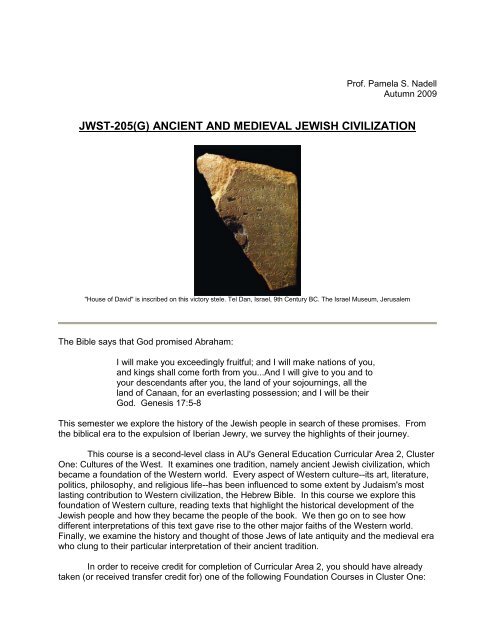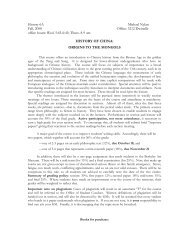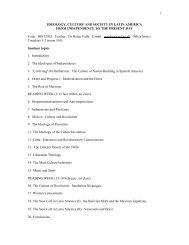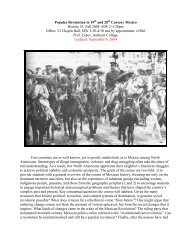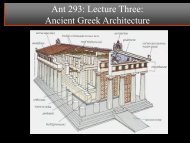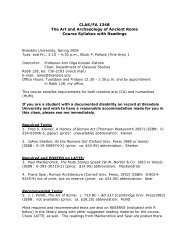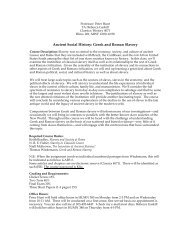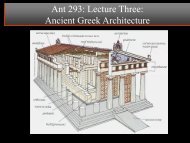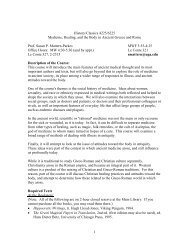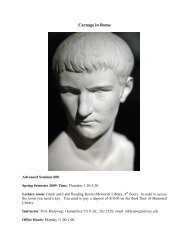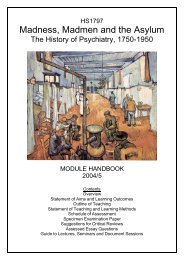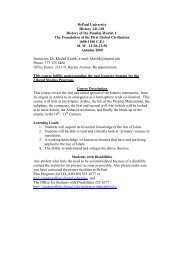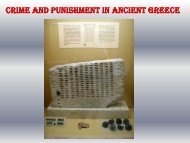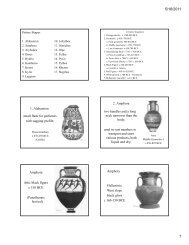ancient and medieval jewish civilization - Mister Dans Home Page
ancient and medieval jewish civilization - Mister Dans Home Page
ancient and medieval jewish civilization - Mister Dans Home Page
Create successful ePaper yourself
Turn your PDF publications into a flip-book with our unique Google optimized e-Paper software.
Prof. Pamela S. NadellAutumn 2009JWST-205(G) ANCIENT AND MEDIEVAL JEWISH CIVILIZATION"House of David" is inscribed on this victory stele. Tel Dan, Israel, 9th Century BC. The Israel Museum, JerusalemThe Bible says that God promised Abraham:I will make you exceedingly fruitful; <strong>and</strong> I will make nations of you,<strong>and</strong> kings shall come forth from you...And I will give to you <strong>and</strong> toyour descendants after you, the l<strong>and</strong> of your sojournings, all thel<strong>and</strong> of Canaan, for an everlasting possession; <strong>and</strong> I will be theirGod. Genesis 17:5-8This semester we explore the history of the Jewish people in search of these promises. Fromthe biblical era to the expulsion of Iberian Jewry, we survey the highlights of their journey.This course is a second-level class in AU's General Education Curricular Area 2, ClusterOne: Cultures of the West. It examines one tradition, namely <strong>ancient</strong> Jewish <strong>civilization</strong>, whichbecame a foundation of the Western world. Every aspect of Western culture--its art, literature,politics, philosophy, <strong>and</strong> religious life--has been influenced to some extent by Judaism's mostlasting contribution to Western <strong>civilization</strong>, the Hebrew Bible. In this course we explore thisfoundation of Western culture, reading texts that highlight the historical development of theJewish people <strong>and</strong> how they became the people of the book. We then go on to see howdifferent interpretations of this text gave rise to the other major faiths of the Western world.Finally, we examine the history <strong>and</strong> thought of those Jews of late antiquity <strong>and</strong> the <strong>medieval</strong> erawho clung to their particular interpretation of their <strong>ancient</strong> tradition.In order to receive credit for completion of Curricular Area 2, you should have alreadytaken (or received transfer credit for) one of the following Foundation Courses in Cluster One:
2ARTH-100G European Art: From Cave to CathedralLIT-125G Great Books That Shaped the Western WorldHIST-100G Historians <strong>and</strong> the Living PastHIST-110G Renaissance <strong>and</strong> Revolutions: Europe, 1400-1815WGST-150G Women's Voices through TimeAncient <strong>and</strong> Medieval Jewish Civilization explores from a new perspective ideas <strong>and</strong> topicsintroduced in those classes. Many of the sources we read, like the Bible, contain the literaryrecord of the remarkable journey of the <strong>ancient</strong> Jews. And many of the events we study--suchas the fall of Jerusalem in 70 C.E.--were commemorated in monuments highlighted in Europeanart. The result of our study will be, I hope, your growing underst<strong>and</strong>ing of the Jews of the past,how they differ from Jews today, <strong>and</strong> an enhanced awareness of the role the Jews played informing the traditions that shape the Western world.Texts1. Tanakh. (This is the Jewish Publication Society translation of the Bible) ISBN:0827603665.Or any edition of the Bible. Note: The King James Version of the Bible is available on-line athttp://etext.lib.virginia.edu/kjv.browse.html. But if you wish to use this, you must print out thesections we are reading <strong>and</strong> bring them to class.2. Eli Barnavi, A Historical Atlas of the Jewish People. ISBN:97808052422633 Jonathan D. Sarna, A Time to Every Purpose ISBN:97804650024674. Raymond Scheindlin, A Short History of the Jewish People. SUGGESTED. [The first fourchapters of this book provide an overview of the historical eras of our course. They serve as auseful review.] ISBN:9780195139419Student Responsibilities1. Class attendance <strong>and</strong> participation, 10 percent of final grade. More than six absencesconstitute grounds for failure.There are no excused or unexcused absences. I recognize that, over the course of thesemester, many students will miss a class or two for illness or for another reason. Do note thatperfect attendance guarantees an A for this 10 percent of your grade even if you never say aword in class. (See also “Technology during Class” below.)2. Reading prompts. See assignment. Ten percent of final grade.3. Paper, 30 percent of final grade, due Monday, November 9 th . See assignment.4. Mid-term examination, October 5 th , 25 percent of final grade.5. Final examination, December 10, 8:30-11:00, 25 percent of final grade.Office hours <strong>and</strong> contactsOFFICE HOURS: Battelle-Tompkins 155; Mondays 11:15-2:00, 3:30-5:00, <strong>and</strong> Thursdays11:15-1:00.PHONE <strong>and</strong> VOICE MAIL: 202-885-2425. E-mail: pnadell@american.eduTEACHING ASSISTANT: Cigdem Pakel, cp9452a@student.american.eduOffice Hours: Wednesday 10:30-12:00 (I will let you know when these start), <strong>and</strong> by
3appointment; Battelle-Tompkins T01/T03GENERAL EDUCATION ASSISTANT: Carolyn Wilson, carolyn3wilson@gmail.com, cell: 631-745-0676; Battelle-Tompkins T01/T03.ACADEMIC INTEGRITY: St<strong>and</strong>ards of academic conduct are set forth in the University'sAcademic Integrity Code. By registering, you have acknowledged your awareness of theAcademic Integrity Code, <strong>and</strong> you are obliged to become familiar with your rights <strong>and</strong>responsibilities as defined by the Code. Violations of the Academic Integrity Code will not betreated lightly, <strong>and</strong> disciplinary actions will be taken should such violations occur. Please seeme if your have any questions about the academic violations described in the Code in generalor as they relate to particular requirements for this course.TECHNOLOGY DURING CLASS: I am, as much as anyone, a fan of the new technologies <strong>and</strong>welcome appropriate use during class. I define appropriate use to mean that you may use alaptop to take notes, to access documents on e-reserves, <strong>and</strong>, AT MY REQUEST, to retrieveinformation from the web. I define inappropriate use to include, but not be limited to, thefollowing: “texting” during class, reading your e-mail, writing on your friends’ Facebook walls,watching YouTube, using IM, shopping on line, or surfing the web. If I discover that youuse technology inappropriately during class time, you will be markedabsent for that class.EMERGENCY PREPAREDNESSIn the event of a declared p<strong>and</strong>emic (influenza or other communicable disease), AmericanUniversity will implement a plan for meeting the needs of all members of the universitycommunity. Should the university be required to close for a period of time, we are committed toensuring that all aspects of our educational programs will be delivered to our students. Thesemay include altering <strong>and</strong> extending the duration of the traditional term schedule to completeessential instruction in the traditional format <strong>and</strong>/or use of distance instructional methods.Specific strategies will vary from class to class, depending on the format of the course <strong>and</strong> thetiming of the emergency. Faculty will communicate class-specific information to students via AUe-mail <strong>and</strong> Blackboard, while students must inform their faculty immediately of any absence dueto illness. Students are responsible for checking their AU e-mail regularly <strong>and</strong> keepingthemselves informed of emergencies. In the event of a declared p<strong>and</strong>emic or otheremergency, students should refer to the AU Web site (www. prepared. american.edu) <strong>and</strong> theAU information line at (202) 885-1100 for general university-wide information, as well as contacttheir faculty <strong>and</strong>/or respective dean’s office for course <strong>and</strong> school/ college-specific information.SHOULD THE UNIVERSITY CLOSE!: The university has asked all faculty to determine howbest to meet their classes, should the university be forced to close, as many schools were lastspring, because of the flu p<strong>and</strong>emic. If the university closes, we will convene on Blackboardduring our regularly scheduled class time. Log into Blackboard <strong>and</strong> link to Discussion Forum. Iwill use the forum to take attendance <strong>and</strong> also to hold class during our regular time. We mayspend the class period on Discussion Board, or I may give you an assignment which will be duevia email by the end of the hour. In any event, if the university is closed, I expect to conveneour class via Blackboard.
4History Department GoalsJWST-205 counts as a course in <strong>ancient</strong> of <strong>medieval</strong> history for History majors <strong>and</strong>minors. As such, it emphasizes the following goals:Historical Literacy: Students will gain an underst<strong>and</strong>ing of the scope, breadth <strong>and</strong> richness ofhistorical studies.Critical Thinking: Students will learn to apply historical methods to evaluate critically therecord of the past <strong>and</strong> how historians <strong>and</strong> others have interpreted it.Communication Skills: Students will learn to organize <strong>and</strong> express their thoughts clearly <strong>and</strong>coherently both in writing <strong>and</strong> orally.Original Research: One of the stepping stones towards an original research project is learningto analyze primary sources. The semester paper for this class emphasizes developing that skill.SYLLABUS8-24 I) Introduction8-27 Naming, Archaeology, Scripture, <strong>and</strong> the Historical-Critical ApproachJohn Corrigan, et al., Jews, Christians, <strong>and</strong> Muslims, pp. 3-12 on BlackboardEli Barnavi, A Historical Atlas of the Jewish People, Introduction III:Demography, p. 1II) Ancient Israel: One God <strong>and</strong> the Chosen PeopleA. Early Israelite History8-31 1. The Patriarchs <strong>and</strong> Patriarchal ReligionGenesis, chapters 1-26:5; Barnavi, Atlas, 2-39-3 2. Egypt, the Exodus, <strong>and</strong> Israelite MonotheismExodus, chs. 1-24, Barnavi, Atlas, 4-7Nahum Sarna, “Israel in Egypt: The Egyptian Sojourn <strong>and</strong> the Exodus,” inAncient Israel, ed. Hershel Shanks, pp. 33-45, on BlackboardRaymond Scheindlin, A Short History of the Jewish People, pp. 1-24SUGGESTED3. Forging the Nation: The Laws of the Book of the Covenant9-10 Reading the Jewish past in the Jewish presentJonathan D. Sarna, A Time to Every Purpose,, all.
59-14 4. Joshua, Judges, <strong>and</strong> the Conquest <strong>and</strong> Settlement of CanaanNumbers, ch. 13-14; Joshua, chs. 1-11, 13:1, 23-24; Judges, chs. 1-5Marc Brettler, How to Read the Bible, 95-105 on Blackboard9-17 B. The First Commonwealth <strong>and</strong> the Chosen King, 1030 B.C.E.1. The United Monarchy: Saul, David, <strong>and</strong> SolomonI Samuel, chs. 1-4:18, 7:5-ch. 11, 13, 16-19, 25, 31; II Samuel, chs. 6-7, 11-12; I Kings, ch. 1Robert Pinsky, The Life of David, 23-43, 98-1179-21 2. The Divided Kingdoms: Israel (to 722 B.C.E.), Judah (to 586 B.C.E.)I Kings 17-19, 21; II Kings 1-2.3. Non-Classical ProphecyMarc Brettler, How to Read the Bible, 137-47 on Blackboard9-24 4. Classical Prophecy <strong>and</strong> Prophetic ReligionAmos, allIsaiah, chs. 6, 43-459-28 No Class – Yom Kippur10-1III) Second Commonwealth: Other Worlds <strong>and</strong> PhilosophiesAffect the Development of Jewish CivilizationA. The Exiles in BabyloniaScheindlin, A Short History of the Jewish People, pp. 25-50, SUGGESTEDMarc Brettler, How to Read the Bible, 199-208 on BlackboardB. Under Persian Rule1. The ReturnIsaiah, ch. 45; Ezra, chs. 1-6; Barnavi, Atlas, 28-292. The Reforms of Ezra <strong>and</strong> NehemiahEzra, chs. 7-10; Nehemiah, chs. 1-2, 8-13; Barnavi, Atlas, 30-3310-5Midterm Exam10-8 C. Hellenism <strong>and</strong> the HasmoneansLee Levine, “The Age of Hellenism: Alex<strong>and</strong>er the Great <strong>and</strong> the Rise <strong>and</strong> Fallof the Hasmonean Kingdom,” in Ancient Israel: From Abraham to theRoman Destruction of the Temple, on Blackboard1. Alex<strong>and</strong>er’s Conquest <strong>and</strong> HellenizationFlavius Josephus, Antiquities of the Jews, go to
10-12 Paper Topic Duehttp://www.ccel.org/j/josephus/works/ant-12.htm; scroll down to thedocument, “King Antiochus to Ptolemy, Sendeth greeting,” print just thissection <strong>and</strong> bring it to classBarnavi, Atlas, 34-35, 40-412. Maccabean RebellionI Maccabees, 1-2 (in the Apocrypha, if you have a Christian Bible); if not,access it at http://eawc.evansville.edu/texts/nepage.htmBarnavi, Atlas, 44-45Guest Lecture: Eric Cline, “Biblical Archaeology: A Short Introduction”10-15 3. The Hasmonean StateI Maccabees, 14 (in the Apocrypha, if you have a Christian Bible); if not,access it at http://eawc.evansville.edu/texts/nepage.htmBarnavi, Atlas, 46-47IV. Roman Rule: The Evolution of Diverse <strong>and</strong> LastingReligious Traditions6A. Roman Conquest <strong>and</strong> Rule: Political Background <strong>and</strong> SourcesScheindlin, A Short History of the Jewish People, pp. 51-70, SUGGESTEDShaye J.D. Cohen, “The Jewish Revolt <strong>and</strong> the Destruction of the SecondTemple,” in Ancient Israel: From Abraham to the Roman Destruction ofthe Temple, pp. 265-99, on Blackboard10-19 B. The Jewish War (66-70 C.E.), Masada, <strong>and</strong> the Bar Kochba Revolt (132-35C.E.)Flavius Josephus, Jewish War, Book VII, chs. 8-9; access athttp://ccel.org/j/josephus/works/war-7.htmBarnavi, Atlas, 52-53, 60-6110-22 C. Religious Sects1. Sadducees2. Essenes“Scrolls from the Dead Sea: The Ancient Library of Qumran <strong>and</strong> ModernScholarship,” browse the Library of Congress exhibit, especially theartifacts, on line at http://www.loc.gov/exhibits/scrolls/10-2610-293. Early ChristiansThe Gospel According to Mark in the New Testament in the ChristianBible; you may access the King James Version at
7http://etext.lib.virginia.edu/kjv.browse.htmlBarnavi, Atlas, 54-5511-2 4. From Pharisees to RabbisBarnavi, Atlas, 56-59Nahum N. Glatzer, ed., The Judaic Tradition: The Seder Ceremony fromMishnah Pesachim, pp. 188-190; Exile <strong>and</strong> Redemption from theTalmud <strong>and</strong> the Midrash, pp. 235-39 on BlackboardMishnah Avot 1:1-2:1, available fromhttp://www.shechem.org/torah/avot.htmlPhilip S. Alex<strong>and</strong>er, Textual Sources for the Study of Judaism, pp. 78-83— only nos. 4.1, 4.5, 4.7, on BlackboardV. The Early Middle Ages: The Rabbis Concretize their Visionamidst Dominant Religious Faith11-5 A. Two Centers of Rabbinic Judaism: Palestine <strong>and</strong> Babylonia, 200-500Online Jewish History Sourcebook: Jews <strong>and</strong> the later Roman Law, 315-531C.E.; access at http://www.fordham.edu/halsall/<strong>jewish</strong>/jewsromanlaw.htmlBarnavi, Atlas, 64-69Lawrence H. Schiffman, From Text to Tradition: A History of Second Temple<strong>and</strong> Rabbinic Judaism, pp. 244-65, on BlackboardPhilip S. Alex<strong>and</strong>er, Textual Sources for the Study of Judaism, pp. 70-71, onBlackboardJudith Romney Wegner, “The Image <strong>and</strong> Status of Women in ClassicalRabbinic Judaism,” in Jewish Women, 73-100Barnavi, Atlas, 62-63, 102-0311-9 B. The TalmudPapers Due11-1211-16C. Jews in the Orbit of IslamGuest Lecture: Cigdem Pakel, “An Introduction to Islam”Scheindlin, A Short History of the Jewish People, pp. 71-96, SUGGESTEDOnline Jewish History Sourcebook:1) Islam <strong>and</strong> the Jews: The Pact of Umar, 9th Century CE, access athttp://www.fordham.edu/halsall/<strong>jewish</strong>/jews-umar.html2) On Samuel Ha-Nagid, Vizier of Granada, access athttp://www.fordham.edu/halsall/source/ha-nagid.html3) Maimonides: The 13 Principles, access athttp://www.fordham.edu/halsall/source/rambam13.html (only the 13principles; do not read the essay by Rabbi Shmuel Boteach that follows).
Barnavi, Atlas, 80-81, 86-87, 90-91Maria Rosa Menocal, Ornament of the World: How Muslims, Jews, <strong>and</strong>Christians Created a Culture of Tolerance in Medieval Spain, pp. 79-90,on BlackboardV. The Middle Ages: New Stages in the Development ofWestern Anti-Judaism, 1000-1500811-1911-23A. The Jews under Latin ChristendomRobert Chazan, The Jews of Medieval Western Christendom, 1000-1500, 43-76,on BlackboardScheindlin, A Short History of the Jewish People, pp. 87-122, SUGGESTEDOnline Medieval Sourcebook:1) Solomon bar Samson: The Crusaders in Mainz, May 27, 1096, access athttp://www.fordham.edu/halsall/source/1096jews-mainz.html2) Lateran IV: Canon 68 - on Jews, access athttp://www.fordham.edu/halsall/source/lat4-c68.html3) The Life <strong>and</strong> Miracles of St. William of Norwich, 1173, access athttp://www.fordham.edu/halsall/source/1173williamnorwich.html4) The Black Death <strong>and</strong> the Jews 1348-1349 CE, access athttp://www.fordham.edu/halsall/<strong>jewish</strong>/1348-jewsblackdeath.html5) The Expulsion of the Jews from France, 1182 CE, access athttp://www.fordham.edu/halsall/<strong>jewish</strong>/1182-jewsfrance1.htmlBarnavi, Atlas, 110-11Robert Chazan, European Jewry <strong>and</strong> the First Crusade, pp. 50-60, onBlackboardRobert Chazan, The Jews of Medieval Western Christendom, 1000-1500, 257-67, on Blackboard11-3012-3B. Sephardic JewryOnline Jewish History Sourcebook:1) Bernard Gui: Inquisitorial Technique (c.1307-1323), access athttp://www.fordham.edu/halsall/source/heresy2.html2) The Expulsion from Spain, 1492 CE, access athttp://www.fordham.edu/halsall/<strong>jewish</strong>/1492-jews-spain1.htmlBarnavi, Atlas, 120-21Jane Gerber, The Jews of Spain: A History of the Sephardic Experience, pp.ix-xxv, on Blackboard12-10 Final Examination, 8:30-11:00 am


